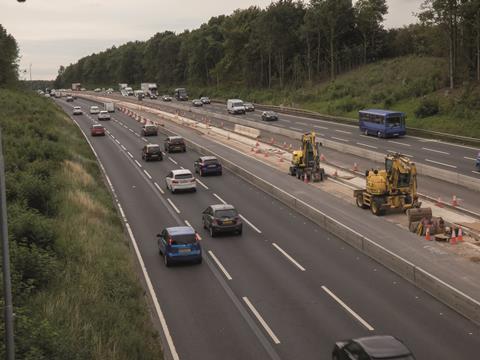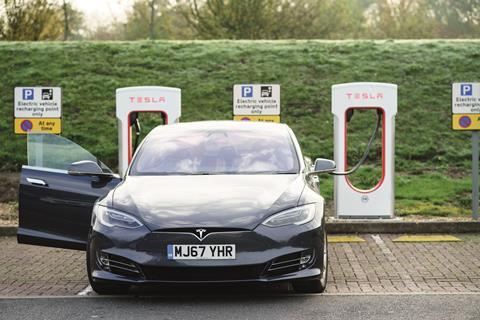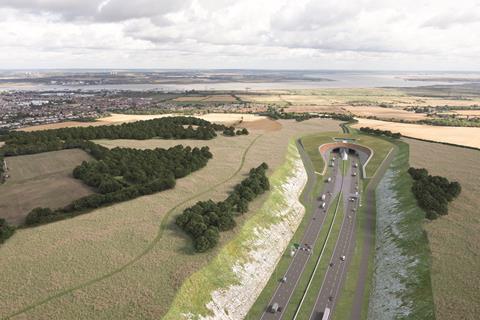Highways England is about to embark on a massive road investment programme, RIS2, for 2020-25. Agnieszka Krzyzaniak and Nora Taylor of Arcadis explore how it will go about delivering the programme efficiently while aiming to minimise environmental impact and increasing its focus on road user experience

01 / Introduction
Although the 2020 Budget will be remembered principally for the chancellorŌĆÖs covid-19 response, it also confirmed a ┬Ż27.4bn allocation for the Road Investment Strategy (RIS2), the largest funding settlement ever made in England for roads investment. With a portfolio of 29 schemes starting construction in early 2020, Highways England (HE) is in a strong position to accelerate the upgrade and expansion of the Strategic Road Network (SRN) over the 2020-25 period of RIS2.
The SRN has a critical economic role. Though representing only 2% of the countryŌĆÖs roads by mileage, it supports 34% of all road traffic including 69% of lorry traffic. Delay and disruption resulting from capacity constraints or roadworks has a significant economic cost as well as being frustrating for users. Customer demand is showing no sign of easing off, and road use increased by 11% between 2013 and 2018. However, the SRN is a hugely complex network that operates as part of a much larger multiŌĆæmodal national transport system. Any change to one element alters the balance of the system and can cause big problems for critical users such as road hauliers. On top of the usual challenges, the impact of covid-19 on traffic levels will need to be assessed to inform the planning of upgrades and renewals of an increasingly ageing infrastructure.
HE was formed in 2015 as a government-owned company charged with operating, maintaining and improving EnglandŌĆÖs motorways and major A roads. Its first programme, RIS1, is considered successful, albeit that key stakeholders such as transport passenger watchdog Transport Focus keep demanding ever higher standards. Over the five-year programme of RIS1 running from 2015 to 2020, HE delivered 44 schemes worth ┬Ż6.3bn, will deliver RIS1 efficiency savings worth ┬Ż1.2bn, and through early-stage development work has built the foundations for the expanded programme for delivery up to 2025, RIS2.
HE has key objectives on its three priorities of safety, serving the customer, and efficient delivery of the road investment programme:
- Safety concerns both road users and road workers, and there is a big programme of innovation planned to reduce the requirement for an on-road workforce as well as a safety programme for single-carriageway corridors.
- Serving the customer will continue to be focused on the enhancement of safety, journey times and road condition, but there is a growing interest in customers who are not drivers, such as pedestrians, cyclists and other road users who are affected by the SRN.
- Delivery of the programme will unlock wider benefits including economic levellingŌĆæup across the country, enabling of new housing and jobs, and connecting up new infrastructure such as the HS2 rail network, ports and airports.
To meet these complex and evolving objectives, HE has been changing fast. It has prioritised the development of new skills and capabilities in digital technologies and data to better create and manage the network and in doing so is becoming a more diverse organisation. Its aim is that everyone within the organisation and its project teams should focus on the user and how the network supports them.
02 / Greater focus on the customer
Highways England is undergoing a vital transformation from an asset-centric organisation to one focused on customer experience. This means investments are planned to deliver outcomes and benefits rather than simply infrastructure assets, with a shift in mindset that is enabling HE and its teams to focus on the key operational aspects of an investment. An example has been the forward planning for operational expenditure associated with variable-speed lanes ŌĆō involving a combination of technology and people on the ground to ensure safe operation and enforcement. Whole-life thinking has been essential, as the design, construction and operation of the asset cannot be separated from the ways in which users will behave and be affected both during construction and after completion.
Changing expectations mean that customers no longer distinguish between particular means of transport, but rather merge them into journeys or services. The definition of SRN customers is so much broader than vehicle passengers: whether users are transporting freight, commuting to work, travelling by coach to an airport, crossing a highway while cycling, or ordering an item for same-day delivery, they all depend on the quality and predictability of road journeys.
As diverse as the SRNŌĆÖs customers are, though, they do share an expectation that conditions on the roads will enable safe, predictable, comfortable and seamless journeys. For hauliers, for example, having early warning of road closures is absolutely critical. However, the reality is that on a busy network such as the SRN, asset condition problems cannot be improved without causing disruption. Providing advance information and managing expectations around closures and congestion is a key element of the customer experience equation.
The user perspective extends beyond road users. It includes people who live close to busy roads and whose neighbourhoods have been changed as a result of the expanded network or a temporary diversion. The 2016 options consultation for the Lower Thames Crossing received 47,000 responses, and the statutory consultation in 2018 received 29,000. Typically, the interests of stakeholders will focus on environmental impacts such as loss of habitat, or the potential for the creation of jobs and homes. Would-be customers should also be taken into account: these include people who at the moment are not actively using the highways as well as those who, motivated by the environmental concerns, may require an EV charging capability within the next few years.
The solutions developed in response to these varied needs extend across the full range of development and operational activities, from well-managed consultation processes to driver buy-in to the discipline of variable-speed lanes. As in all walks of life, digital systems and data have a critical user-facing role, fully integrated with the physical infrastructure ŌĆō ranging from smart asset management systems that optimise maintenance to traffic flow monitoring and speed control based on artificial intelligence and image recognition.
03 / Addressing the efficiency challenge
Highways England is a regulated body and is subject to a robust performance challenge by the Office for Rail and Road (ORR). HE is targeting a further efficiency improvement of 7.8% through to 2025. In a strategic assessment concluded ahead of RIS2, four big opportunities have been identified in the capital programme: standardised products, digital solutions, collaborative procurement and effective management of risk.
None of these opportunities can be addressed purely on a piecemeal, project-by-project basis, so HE has taken a portfolio-wide approach, establishing a centralised Programme Management Office (PMO) and a ┬Ż8.7bn Regional Delivery Partnership (RDP) structure as well as developing portfolio-wide benchmarks.
HEŌĆÖs procurement strategy highlights the importance of scale in achieving a step change in practice. Each of the 13 partner joint ventures on the roads programme has been awarded enough work to support investment in new ways of working, and future contracts are likely to be allocated on the basis of alignment with HEŌĆÖs key priorities as well as performance.
Not all work will be delivered via the RDP. Two other programmes ŌĆō the Complex Infrastructure Programme and the Smart Motorways Programme ŌĆō will also have sufficient scale to promote similar levels of performance improvement.
Standardisation
The greatest potential for improving efficiency lies with standardisation, but this relies heavily on a common design and delivery approach across the programme. Like many construction clients, HE has been experimenting with offsite manufacture for many years but has not always been able to create a pipeline big enough to trigger investment in new standard products and new capacity. The RDP programme should unlock this opportunity. Offsite manufacturing is known to deliver many benefits associated with safety and quality, but the priority for HE is to unlock labour and plant efficiency. This will depend on predictable and consistent use of plant and people.
Digital
Digital is seen as an essential precursor of product standardisation but also has the potential for a huge impact on projects from the earliest stages through to operation and renewal. HEŌĆÖs Rapid Engineering Model, which automates many aspects of smart motorway design, is another good example of how efficiency gains can be driven across the programme, but there are many opportunities to integrate BIM, GIS (geographical information systems) and other critical information such as the detailed hazard identification schedules developed for all highways schemes. The increasing automation of processes including cost estimating, inventory management and labour allocation is improving efficiency and creating the data needed to drive further stages of optimisation linked to benchmarking and use of shared data.
Collaboration and risk management
The adoption of digital tools and standardisation are a huge challenge for HEŌĆÖs project teams. However, the changes required by HEŌĆÖs adoption of collaborative procurement go much further, tackling the extent to which transactional behaviours are embedded in the industry. HEŌĆÖs approach sets out to eliminate the cost of distrust, for instance by stopping risk allocation within a team becoming a barrier to productivity.
HEŌĆÖs approach is genuinely innovative and is being delivered at great enough scale to drive change in the UK civils sector. Lessons learned from the RDP could be applied to a much wider range of programmes.
04 / How design and engineering can contribute to efficient delivery
The big step change in design and engineering over the five-year course of the RIS1 programme has been the scale of digital transformation. As the use of digital information becomes increasingly seamless, design and engineering will be able to make a greater contribution to enabling efficiency at all stages of HEŌĆÖs three-phase, seven-stage Project Control Framework, especially if based on standard product sets.
During the options stage, geographical information systems (GIS) enable a huge amount of data to be managed in an effective way, including initial survey data and the ecology baseline, while also factoring in wider constraints and hazards. Digital tools such as visualisation and survey analysis play a key role in facilitating a wider consultation process.
During the development stage, three key aspects of design increasingly involve aligning the solution to a specific need, optimising the use of standard products, and making the design information useable for the construction supply chains. This is increasingly important now that HE requires schemes to be designed to cost requirements set by benchmarks, rather than having the costs determined by an optimised scheme. In addition to wellŌĆæestablished systems such as GIS and BIM, new tools that support a systems engineering approach to design and specification help ensure not only that all requirements are met but also that features of a scheme can be tied back to a specific need.
As part of the construction phase, the integration of detailed design models with other digital resources ŌĆō such as those relating to scheduling, resource management and materials inventory ŌĆō will minimise duplication and support efficient on-site delivery. The digital models should ideally become the single source of truth for future asset management.
These instances highlight how the gap between design and engineering on the one hand and construction and operation on the other is being closed through data acquisition and exchange. The pace of change will no doubt accelerate during the 2020-25 period of RIS2.

05 / Meeting the climate challenge
Transport is responsible for a larger proportion of the UKŌĆÖs domestic greenhouse emissions (28%) than any other sector, with 89% of these emissions being generated by road vehicles.
The Department for Transport (DfT) has recently published Decarbonising Transport: Setting the Challenge. This report sets a target for ŌĆ£net zero at the tailpipeŌĆØ, emphasising the role that electric vehicles and associated charging infrastructure will play in limiting carbon emissions associated with journeys.
Roads are highlighted as key enablers of active transport, promoting a modal shift by using bicycles and micro-scooters to integrate the wider road network with public transport. The development of more transport hubs alongside the Strategic Road Network will be needed to enable better transport mode integration.
These interventions are designed to address operational carbon emissions. However, this is only part of the story. As traffic-related emissions fall, the management of embodied carbon in the construction and maintenance of the SRN will become more of a priority.
Embodied carbon emissions are generated through the construction, maintenance and disposal of an asset. Many of the materials used in the construction of road infrastructure ŌĆō cement, aggregate, steel and asphalt ŌĆō are high embodied-carbon products obtained from industries in which emissions are hard to abate. This means it is harder to find acceptable product substitutes and also that the cost of carbon reduction at source will be high. Cement producers, for example, will need to start to adopt very expensive carbon capture technology within the next five years if they are to meet net-zero targets.
Additionally, civil engineering relies on the extensive use of high-power diesel plant for cut and fill as well as for aggregate transport, and at present there is no electric substitute for this. Eliminating embodied carbon from road construction seems a long way off, so what can be done to accelerate the transition?
First, a universal methodology for mapping and quantifying carbon emissions from the road infrastructure is needed. HE is in a strong position to undertake this, with a comprehensive quarterly data capture process based on a detailed embodied-carbon database. This data can be used during the design and construction process, allowing mitigations for embodied-carbon hotspots to be identified, prioritised and implemented.
Second, more R&D focused on alternative construction materials is needed. A lot of development has already taken place: recycled aggregates and asphalt are now widely used, and producer Cemex, for example, has launched in 2020 a ŌĆ£carbon-neutralŌĆØ ready-mixed concrete suitable for civils projects.
Third, there needs to be more incentive to use the technologies that are already available. This will involve HE not only updating its standard specifications, but also underwriting demand while manufacturers scale up to achieve economies of scale.
There are many other aspects of sustainability that HE must address over the five years of RIS2. Making more use of the green infrastructure associated with roads to promote net biodiversity gain is a key area, as is addressing the wider resilience of the network. With extreme weather events affecting so many aspects, from melting road surfaces in summer to snowdrifts and floods at other times of year, it is clear that the SRNŌĆÖs sustainability will increasingly have an operational dimension.
Case study: Integration of digital tools on major projects
Arcadis has been appointed on the Lower Thames Crossing (LTC) as part of the Cascade JV with Jacobs and Cowi. The LTC is planned to almost double road capacity to the east of London, relieving congestion on the M25 and increasing connectivity and access in the Thames Gateway region. The scheme, estimated to cost between ┬Ż5.3bn and ┬Ż6.8bn, will help to create thousands of jobs and increased investment throughout the country. The commission includes outline design, environmental impact assessment and commercial management. It is unusual for cost planning to be integrated into the design service as it is on this project, and the team have been able to take the opportunity to integrate 5D BIM on one of the most complex sections of the programme ŌĆō the twinŌĆæbore tunnels.
Conversion of 3D models to smart 5D models has fully automated the cost planning process, increasing speed and transparency of the process and thereby enabling the team to focus more on solution optimisation than on the cost planning process itself.
This innovation has been combined with the adoption of digital systems engineering tools, which enable the team to analyse the functional requirements of the design with respect to performance requirements, technical constraints and planning requirements. The discipline of systems engineering enables the team to demonstrate that the design solution meets customer needs and that there are no unnecessary aspects of optimisation.
The innovative use of these tools is part of a digital strategy that enables digital assets and data to be shared and used across the whole supply chain. This initiative highlights how high-tech approaches can make a major contribution to the achievement of HEŌĆÖs performance goals.

Acknowledgments
The authors would like to thank Tej Bahia, Rebecca Gabriel, Leigh Jones and Elena Vrabie of the Arcadis Highways Team as well as Simon Rawlinson for their contributions to this article.




















No comments yet